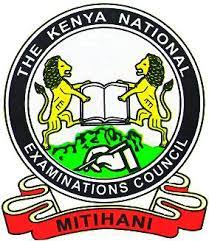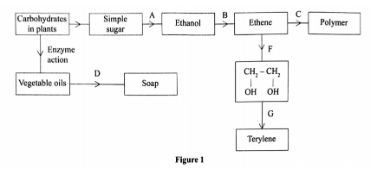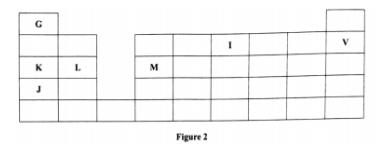
2018 Chemistry paper 2
1. The diagram in figure I shows some natural and industrial processes. Study it and answer the questions that follows

(a) Identify the processes labelled: (2 marks)
A……………….
B……………….
C……………….
D……………….
(b) State the reagents and conditions required for processes B and D.
(i) Process B:
Reagent…………….(1 mark)
Conditions ………… (l mark )
(ii) Process D:
Reagent…………….(1 mark)
Conditions ………… (l mark )
(iii) Describe how process D is carried out.(2 marks)
(iv) State two additives used to improve the quality of soap.(1 marks)
(c) State the reagents required in steps F and G.(1 marks)
(iii) Draw the structure of terylene.(1 marks)
(d) (i) Name the polymer formed in step C.(1 marks)
(ii) State one disadvantage of the polymer formed in (d) (i).(1 marks)
2. Figure 2 is a section of the periodic table. Study it and answer the questions that follow. The letters do not represent the actual symbols of elements

(a) (i) Select elements which belong to the same chemical family.(1 marks)
(ii) Write the formulae of ions for elements in the same period.(1 marks)
(b) The hrst ionisation energies of two elements K and M at random are 577 kJ/mol and 494 tel/mol .(1 marks)
(i) Write equations for the 1 ˢ ᵗ ionisation energies for elements K and M and indicate their energies.(1 marks)
(iii) Write the formula of the compound formed when L and I react.(1 marks)
(iv) Give one use of elemcnt V.(1 marks)
(c) (i) State anothcr group that G can be placcd in Figure 1. Explain. (2 marks)
(ii) How do the reactivity of elements J and K compare? Explain. (2 marks)
(d) (i) Elements L and M form chlorides. Complete the following table by writing the formulae of each chloride and state the nature of the solutions. (2 marks)

(ii) The chloride of element M vapourises easily while its oxide has a high melting point. Explain. (2 marks)
3. (a) Complete Table I by indicating the observations, type of permanent or temporary change and name of new compound formed.

(b) Use the set-up in Figure 3 to answer the questions that follow. The flask was covered with a cloth that had been soaked in ice-cold water.

(i) State the observation made on the coloured water. Explain.(2 marks)
(ii) Name the gas law illustrated in Figure 3.(1 marks)
(c) Use the standard electrode potentials in Table 2 to answer the questions that follow.

(i) Write the half-cell representation for the element whose electrode potential is for hydrogen. (1 mark)
(ii) Arrange the elements in order of reducing power, starting with the weakest reducing agent. (1 mark)
(iii) I Select two half cells which combine to give a cell with the least e.m.f. (1 mark)
II Calculate the e.m.f of the half cells identified in (iii) I. (1 mark)
4. An experiment was carried out to prepare crystals of magnesium sulphate.
Excess magnesi um powder was added to l00cm’of dilute sulphuric(VI) acid in a beaker and warmed until no further reaction took place.
The mixture was filtered and the filtrate evaporated to saturation, then lcft to cool for crystals to form.
(a) (i) Write an equation for the reaction.(1 mark)
(ii) Explain why eKcess magnesium powder was used.(1 mark)
(iii) State how completion of the reaction was determined.(1 mark)
(iv) What is meant by a saturated solution?(1 mark)
(v) Explain why the filtrate was not evaporated to dryness.(2 mark)
(b) When bleaching powder, CaOC1„ is treated with dilute nitric(V) acid, chlorine gas is released.
This reaction can be used to determine the chlorine content of various samples of bleaching powders and liquids.
(i) Write an equation for the reaction of nitric(V) acid with bleaching powder.(1 mark)
(ii) Calculate the volume of chlorine produced when 10 g of CaOC1, is treated with excess nitric(V) acid. (Ca = 40.0; O = 16.0; Cl = 35.5; 1 mole of gas occupies 22.4dm3 at s.t.p) (3 marks)
(c) Apart from use of chlorine gas in bleaches and water treatment, state two other uses of chlorine gas. (1 mark)
5. (a) The diagram in Figure 4 was used to prepare hydrogen chloride gas which was passed over heated iron powder.

(i) Give a pair of reagents that will produce hydrogen chloride gas in flask A. (2 marks)
(ii) Name the substance in flask B.(1 marks)
(iii) State the observation made in the combustion tube.(1 marks)
(iv) Write an equation for the reaction in the combustion tube.(1 marks)
(v) Describe a chemical test for hydrogen chloride gas.(1 marks)
(b) (i) Identify the gas that bums at the jet.(1 marks)
(ii) Explain why the gas in (b) (i) is burned.(1 marks)
(c) Give reasons why excess hydrogen chloride gas is dissolved using the funnel arrangement. (2 marks)
(d) State what will be observed when the reaction in the combustion tube is complete.(1 marks)
(e) Another experiment was carried out where hydrogen chloride gas was bubbled through methylbeiizene and water in separate beakers.
The resulting solutions were tested with blue litmus papers and marble chips.
(i) Write the observations made in the following table.

(ii) Explain the observations in (e) (i).(2 marks)
6. (a) In Kenya, sodium carbonate is extracted from trona at Lake Magadi. (i) Give the formula of trona.
(ii) Name the process of extracting sodium carbonate from trona.(2 marks)
(b) The flow chart in Figure 5 summarises the steps involved in the production of sodium carbonate. Use it to answer the questions that follow.

(i) Name the process illustrated in Figure 5.(1 mark)
(ii) Identify the starting raw materials required in the production of sodium carbonate. (2 marks)
(iii) Write equations for the two reactions that occur in the carbonator. (2 marks)
(iv) Name two substances that are recycled. (v) Identify:
Solid X;…………….(l mark)
Process W……………(l mark)
(vi) Write an equation for the reaction that produces solution Z.(l mark)
(vii) Apart from softening hard water, state two other uses of sodium carbonate. (2 marks)
